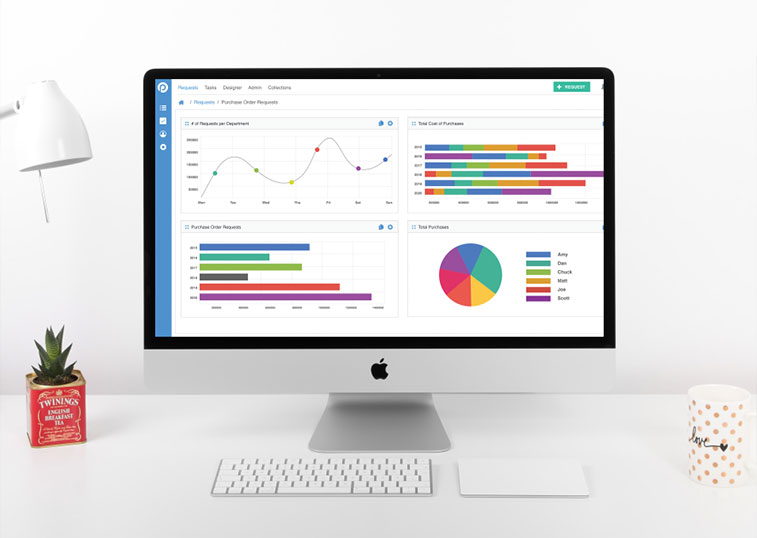Organizations worldwide are discovering with current technology, automation can offload 45% of today’s paid workplace duties. For a fraction of the roughly $2 trillion spent on yearly wages, automated solutions seem like a clear winner. However, any new tool or method can introduce fresh problems if you’re treating symptoms rather than the root issues.
Business process analysis (BPA) ensures you have clarity before moving towards solutions like automation. New technologies are not a standalone solution to your inefficient workflows. Instead, think of your process as the foundation that your performance tech sits atop of.
Once you leverage BPA to refine your process into a strong foundation, automation can reliably augment your process for fewer bottlenecks and more profitability.
To properly leverage BPA, you should follow five invaluable steps to examine, reassess, and refine your process.
1. Know your targets
Step one: Identify your goals and the process that you’re currently using to reach them.
BPA should begin with goal-setting sessions. In other words, where do you want your performance to be? Consider what you hope to accomplish. SMART goals are:
- Specific — to know when your process is meeting the mark.
- Measurable — to track your progress with facts over opinions.
- Attainable — to encourage healthy employee workloads and high morale.
- Relevant — to align with the needs of customers and the business itself.
- Timebound — to foster urgency and help your team prioritize the goalposts.
Now that you know what your ideal results are, you can easily spot which of your existing processes determine your success. Clearly define where each target process starts and ends.
These are the processes you’ll dissect and monitor all throughout your BPA. Be mindful to work through each process one at a time to maintain stability in the wider organization.
2. Learn your current process
Step two: Compile data on your target process as it is today, i.e. the process “as-is.”
No good analysis is complete without lots of data. From the frontlines to management and even adjacent processes, glean every touchpoint of the process for information.
You’ll want an intricate understanding of exactly how your process is currently laid out — on paper and in practice.
In this stage, your analysts are simply students of the process. You’ll be conducting info gathering sessions with all stakeholders to get expert insights, novice observations, and any other relevant perspectives. These might include:
- Staff interviews
- Live process observations
- Team brainstorming sessions
Additionally, you’ll want to locate and gather all the recorded information your team has about the process. Documentation may include:
- Process activity records
- Standard operating procedures (SOPs)
- Unofficial employee-created guides or checklists
Along the way, you’ll often ask: Who does what? When? How? Why? What are the possible results of each action?
The goal here is to thoroughly unpack every available dimension of each step in your process. Only then can you truly see what’s present, what’s missing, and how it all serves your business goals.
3. Visualize your current process
Step three: Map your process as it currently operates today.
Once you’re confident you’ve learned enough to cover possible blind spots, you’re prepared to arrange the information into a clean visual aide.
Business process mapping allows you to literally “map” the process steps in sequence, from beginning to end. You might use a low-code drag-and-drop dashboard to set up elaborate flowcharts, or just a pen and paper.
Regardless of method, the key is to arrange your loose info into a cohesive web — navigating from input to output.
A successful process map settles the ambiguity of your team’s daily actions into a concrete thread of verified steps. Since many teams have a tendency to “set-and-forget” their processes, this step reveals immense value by illustrating the unintended evolutions of your day-to-day operations.
Most importantly, process mapping gives a simple view to pinpoint the “pain” in the process.
4. Spot where to close gaps with BPA
Step four: Identify what areas you can improve in your process.
Based on what you’ve learned, you now have your process stripped to an easy-to-navigate skeleton. From this fundamental view, you can dig through each step to assess what works, what doesn’t, and what can be enhanced.
For example, keep a diligent eye on any actions, tasks, or requirements that are:
- Redundant
- Non-essential
- “Gatekeepers” of progress
- Interdependent on other steps
- Resource drains
- Repetitive
- Manually-completed
- Use lots of paperwork
These suspected problems should be assessed with more questions. As you drill past every symptomatic layer and reveal the root issues, meet these problems with possible solutions. Consider more sessions with your team to get feedback on ideas.
You’d be wise to think sustainable and long-term while considering all effects to everything and everyone linked to the process.
Above all else, remember that your BPA goal-setting should align with your ideas to improve. Pick the steps you’ll eliminate, reduce, streamline, and delegate until you’ve got a gameplan primed for action.
5. Implement, observe, iterate (again, and again…)
Step five: Put the plan into motion and monitor for more ways to improve into the foreseeable future.
Changes will inevitably shake up results across the organization. You’ll need to know what’s different, how it’s changed, and if these outcomes support your goals.
Prioritize and avoid big waves of negative impact by drip-feeding your changes into the process. Pacing the updates gives you room to effectively move to better workflows without disrupting the bigger picture.
Beyond these initial notes, monitoring is not meant to just “maintain,” but to “iterate” continuously. Business and customer needs change with time, so BPA helps businesses change with intention. This step helps you meet these needs by:
- Reassessing each step’s value to the business and customer.
- Refining the process for lean performance.
What’s next after business process analysis?
Truthfully, a successful business process analysis doesn’t end after round one.
Your first run with BPA is the sturdy foundation you’ll need to get the most from process automation. Still, you’ll need to be mindful to track and analyze all future changes to your workflows.
To include your employees among those saving 30% of work time with automation, remain proactive rather than reactive.
With every new adjustment and addition to the process, just remember to:
- Know your targets.
- Re-learn your process.
- Visualize your process.
- Spot the pain and find where to improve.
- Implement changes, observe, and iterate.
As long as you continue to follow these steps, you’ll be on the right track to get the most value from your processes.




